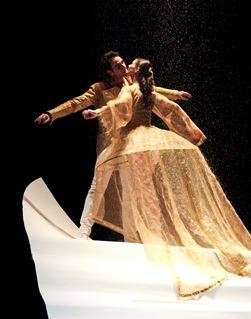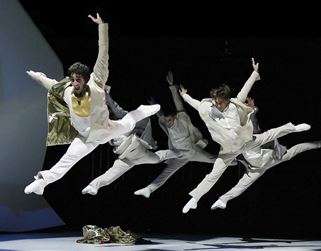|
Back
A Debut in Southern California Orange County
Segerstrom Hall
02/09/2012 - & 10, 11, 12 February 2012
Sergei Prokofiev: Cendrillon, op. 87
Anja Behrend (Cinderella), Asier Uriagereka (The Prince), Mimoza Koike (The Fairy), Chris Roelandt (The Father), Carolyn Rose (The Stepmother), Gaelle Riou/Noelani Pantastico (The Sisters), Gaëtan Morlotti/Jérôme Marchand (The pleasure Superintendents), Stephan Bourgond/Bruno Roque/Ramon Gomes Reis), George Oliveira (The four friends), Giovanni Mongelli/Jeroen Vergruggen/Daniele Delvecchio/Sabry Ghalem-Cherif (The four Mannequins), Francesca Dolci/Sivan Blitzova/Simone Webster/Maude Sabourin (The Exotics),
Les Ballets de Monte Carlo corps de ballet
Jean-Christoph Maillot (Director), Ernest Pignon-Ernest (Scenic Designer), Jérôme Kaplan (Costume Designer), Dominique Drillot (Lighting Designer), Jean-Christoph Maillot (Choreography)

(© Marie-Laure Briane)
The origin of Cendrillon (Cinderella) traces back to Charles Perrault, a prominent contributor to 17th century French literature and core architect of a new genre known as the “fairy tale.” Since that time, the story of happiness trumping unjust oppression has been transformed into many imaginative interpretations. Add this one to the books.
Les Ballets de Monte Carlo makes their Southern California debut of the timeless classic in this eccentric production by Jean-Christophe Maillot. Since taking over as head of the esteemed organization in 1993 at the behest of H.R.H. the Princess of Hanover, Maillot’s artistic take is refreshing yet a bit jarring to the preprogrammed mind. In this Cendrillon a set of desultory elements prevail, meshing real with unreal, familiar with unfamiliar, natural with supernatural. The lines become blurred and are not altogether understood, but that’s Maillot intent: to question the established and expand the horizons of the unexpected.
Vagaries abound as Cinderella’s mother (Mimoza Koike) morphs into The Fairy, perplexing the viewer of what’s comfortable and what’s new. Carolyn Rose’s Stepmother and her two daughters, danced by Gaelle Riou and Noelani Pantastico, all give a wonderful roughened redefinition of crudeness while Gaëtan Morlotti and Jérôme Marchand as the two unconventional pleasure Superintendents gyrate in quirky movements dressed by Kaplan looking like Mr. Clean twins in servant jumpsuits. They’re a hit with the audience. Other uncanny additives are Maillot’s half human half mechanical Mannequins, The Exotics performing a condensed Kabuki-like dance draped in colors of the Chinese flag and a lentil dish from which Cinderella removes her foot only to be draped in sequins. A bit odd you might say? We’re in the land of make believe.

(© Marie-Laure Briane)
Respectively, Anja Behrend and Asier Uriagereka as Cinderella and The Prince are beautifully choreographed by Maillot while set against Prokofiev’s glittering sectional during the pas de deux. They meld in an aesthetically abrupt fashion, yet it’s essentially the only emotionally evocative moment of the evening. The predominant movements are abstract, sharp and a tad acerbic, but highly acrobatic, a reminder of last year’s Don Quixote (Read here) by the Eifman Ballet. Though Cinderella’s legs are often callously stretched wide open suggesting vulgarity, the production is heavily comical and brilliantly cued to Prokofiev’s punctuated score.
The minimal scenery and dispersed imagery by Ernest Pignon-Ernest has tasteful intelligence featuring only a handful of fluidly traveling panels while set against the prerecorded music. Additionally, lighting by Dominique Drillot lends dramatic effect, but Jérôme Kaplan’s costuming is another subject: Cinderella’s work dress is pathetically dull, The Stepmother’s barbed appendage makes her look like an indecent purple scorpion, The Sisters bounce around in bandages during last vestiges onstage, The Father’s black clad suit makes him look more like Cinderella’s youthful boyfriend and only one of the faux osier 17th century hoop panniers (a la plastic) is worn by each of The Sisters, awkwardly bracketing themselves together. But this is supposed to be comical, right?
If one is expecting ballet in the traditional sense, take caution. Add a spoon full of Bournonville pantomime along with a humorous dash of Ballet Trocadero and, voilà, you have a recipe for uncharacteristic invention and unconventional novelty. Clever as it may be, it’s a bit unorthodox.
Christie Grimstad
|